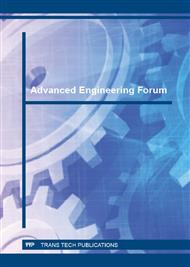[1]
P. G. Thomasson, Modelling, Simulation and Flight Test Experience in the Development of Unstable Robotic Aircraft, Aeronautical Journal 104 (2000) 359-364.
DOI: 10.1017/s0001924000063995
Google Scholar
[2]
A. Brezoescu, T. Espinoza, P. Castillo, R. Lozano, Adaptive trajectory following for a fixed-wing UAV in presence of crosswind, J. Intelligent & Robotic Systems 69 (2013) 257-271.
DOI: 10.1007/s10846-012-9756-8
Google Scholar
[3]
Ren, Wei, and Ella Atkins. Nonlinear trajectory tracking for fixed wing UAVs via backstepping and parameter adaptation. Proceedings of the AIAA Guidance, Navigation, and Control Conference and Exhibit. (2005).
DOI: 10.2514/6.2005-6196
Google Scholar
[4]
Beard, R., D. Kingston, M. Quigley, D. Snyder, R. Christiansen, W. Johnson, T. McLain and M. Goodrich, Autonomous vehicle technologies for small fixed wing UAVs, AIAA Journal of Aerospace Computing, Information, and Communication 2. 1 (2005).
DOI: 10.2514/1.8371
Google Scholar
[5]
Salazar, Sergio, Ivan Gonzalez-Hernandez, Ricardo Lopez, and Rogelio Lozan, Simulation and robust trajectory-tracking for a Quadrotor UAV. Unmanned Aircraft Systems (ICUAS), 2014 International Conference on. IEEE, (2014).
DOI: 10.1109/icuas.2014.6842371
Google Scholar
[6]
Johnson, Eric N., and Suresh K. Kannan, Adaptive flight control for an autonomous unmanned helicopter. AIAA Guidance, Navigation and Control Conference. Vol. 11. Monterey, CA: AIAA, (2002).
DOI: 10.2514/6.2002-4439
Google Scholar
[7]
Sugeno, M., I. Hirano, S. Nakamura and S. Kotsu, Development of an intelligent unmanned helicopter, Proceeding of IEEE Int. Fuzzy Syst. Conference 5 (1995) 33–34.
DOI: 10.1109/fuzzy.1995.410029
Google Scholar
[8]
Salman, Shaaban A., G. Sreenatha, and Y. C. Jin, Indirect adaptive fuzzy control of unmanned aerial vehicle, presentado al 17th IFAC World Congress (IFAC'08), Seoul, Korea. (2008).
DOI: 10.3182/20080706-5-kr-1001.02241
Google Scholar
[9]
C. Silvestre, A. Pascoal and I. Kaminer, On the design of gain-scheduled trajectory tracking controllers, International Journal of Robust and Nonlinear Control 12. 9 (2002) 797-839.
DOI: 10.1002/rnc.705
Google Scholar
[10]
J. J. E. Slotine and W. Li, Applied Nonlinear Control, Prentice Hall, Englewood Cli's, (1991).
Google Scholar
[11]
H. Khalil, Nonlinear Systems, Macmillan, New York, (1992).
Google Scholar
[12]
P. V. Kokotovic, The joy of Feedback: Nonlinear and Adaptive, IEEE Control Systems 12. 3, (1992) 7-17.
Google Scholar
[13]
M. Krstic, I. Kanellakopoulos and P. V. Kokotovic, Nonlinear and Adaptive Control Design, John Wiley & Sons, New York, (1995).
Google Scholar
[14]
J.P. Hespanha, D. Liberzon, A.S. Morse, Overcoming the limitations of adaptive control by means of logic-based switching, Systems & Control Letters 49 (2003) 49 – 65.
DOI: 10.1016/s0167-6911(02)00342-0
Google Scholar
[15]
A.S. Morse, Supervisory control of families of linear set-point controllers, Part 1: exact matching, IEEE Trans. Automat. Control 41 (1996) 1413–1431.
DOI: 10.1109/9.539424
Google Scholar
[16]
K.S. Narendra, J. Balakrishnan, Adaptive control using multiple models, IEEE Trans. Automat. Control 42 (1997) 171–187.
DOI: 10.1109/9.554398
Google Scholar
[17]
M. Fu, B.R. Barmish, Adaptive stabilization of linear systems via switching control, IEEE Trans. Automat. Control 31 (1986) 1097–1103.
DOI: 10.1109/tac.1986.1104187
Google Scholar
[18]
E.B. Kosmatopoulos, P. Ioannou, A switching adaptive controller for feedback linearizable systems, IEEE Trans. Automat. Control 44 (1999) 742–750.
DOI: 10.1109/9.754811
Google Scholar
[19]
A.S. Morse, Supervisory control of families of linear set-point controllers Part 2: robustness, IEEE Trans. Automat. Control 42 (1997) 1500–1515.
DOI: 10.1109/9.649687
Google Scholar
[20]
J.P. Hespanha, D. Liberzon, A.S. Morse, B.D.O. Anderson, T.S. Brinsmead, F. deBruyne, Multiple model adaptive control Part 2: switching, Internat, J. Robust Nonlinear Control 11, (2001) 479–496.
DOI: 10.1002/rnc.594
Google Scholar
[21]
J.P. Hespanha, D. Liberzon, A.S. Morse, Logic-based switching control of a nonholonomic system with parametric modeling uncertainty, Systems Control Lett. 38 (1999) 167–177.
DOI: 10.1016/s0167-6911(99)00062-6
Google Scholar
[22]
Liberzon, Daniel, and João P. Hespanha, Hierarchical hysteresis switching, Decision and Control, 2000. Proceedings of the 39th IEEE Conference on. Vol. 1. IEEE, (2000).
DOI: 10.1109/cdc.2000.912812
Google Scholar
[23]
F.M. Pait, F. Kassab Jr., On a class of switched, robustly stable, adaptive systems, Internat. J. Adaptive Control Signal Process 15 (2001) 213–238.
DOI: 10.1002/acs.665
Google Scholar
[24]
Gómez-Gutiérrez, David, Sergej Čelikovský, Antonio Ramírez-Treviño, and Bernardino Castillo-Toledo, On the observer design problem for continuous-time switched linear systems with unknown switchings. J. the Franklin Institute 352. 4 (2015).
DOI: 10.1016/j.jfranklin.2015.01.036
Google Scholar


